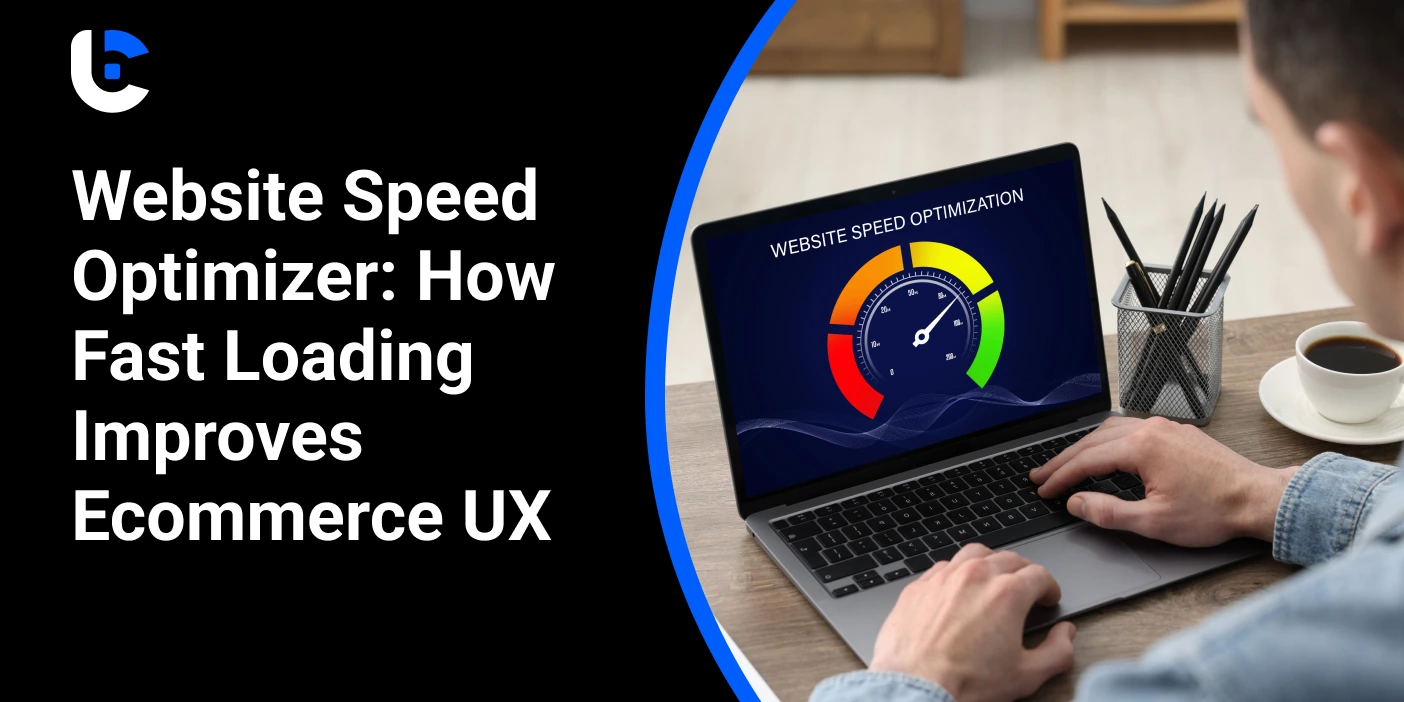Table Of Contents:
Introduction
In the fast-paced world of ecommerce, every second counts. Imagine a shopper landing on your online store, excited to browse your products, only to be met with a sluggish website that takes ages to load. Frustration sets in, and within moments, they’re gone, likely to a competitor’s site that delivers a seamless experience. This scenario isn’t just a hypothetical; it’s a reality backed by data: 40% of users abandon a website that takes longer than 3 seconds to load. That’s a massive chunk of potential revenue slipping through your fingers.
Enter the game-changer: a website speed optimizer. By prioritizing fast loading times, you’re not just improving your site’s performance, you’re revolutionizing the ecommerce UX (user experience) and unlocking a cascade of benefits, from higher conversions to better SEO rankings.
Why Website Speed Matters in Ecommerce
Let’s start with a hard truth: your customers aren’t patient. Studies show that 47% of shoppers expect a webpage to load in 2 seconds or less. If your site doesn’t meet that expectation, you’re not just losing a sale, you’re losing trust, loyalty, and future opportunities. Here’s why site performance is non-negotiable in ecommerce:
1. First Impressions Are Everything
Your website is often the first touchpoint a customer has with your brand. A slow-loading page sends a message of unreliability, while a fast, responsive site screams professionalism and care. Fast loading times create a positive first impression, setting the stage for a smooth shopping journey.
2. Speed Drives Conversions
The correlation between page load speed and conversion rates is undeniable. For every second your website takes to load, you risk a significant conversion drop. For example, a site that loads in 2.4 seconds can see a 1.9% conversion rate, while shaving off a second can boost that number dramatically. For an ecommerce store generating $10 million annually, a 2% increase in conversions could mean an extra $200,000 in revenue. That’s the power of a website speed optimizer.
3. Mobile Shoppers Demand Speed
With over 60% of ecommerce traffic coming from mobile devices, mobile speed is critical. Mobile users are often on the go, with less patience for delays. A slow mobile site can lead to higher bounce rates and abandoned carts, especially during high-traffic events like Black Friday. Optimizing for mobile speed ensures your store is accessible and enjoyable, no matter the device.
4. SEO Performance Hinges on Speed
Google loves fast websites. Site performance is a key ranking factor, with Core Web Vitals,, metrics like Largest Contentful Paint (LCP), First Input Delay (FID), and Cumulative Layout Shift (CLS), playing a pivotal role in determining your search engine rankings. A slow site frustrates users and tanks your SEO, reducing visibility and organic traffic.
5. Speed Enhances Customer Retention
A fast-loading site doesn’t just attract new customers; it keeps them returning. A seamless ecommerce UX builds trust and encourages repeat purchases. Customers who navigate your store effortlessly are more likely to become loyal advocates for your brand.
The Hidden Costs of a Slow Ecommerce Website
A slow website isn’t just an inconvenience; it’s a silent revenue killer. Let’s break down the tangible and intangible costs of neglecting page load speed:
- Lost Sales: A two-second delay in load time can double your bounce rate, meaning you lose nearly half your visitors before they see your products.
- Poor Customer Satisfaction: Slow sites lead to a 16% decrease in customer satisfaction, which can tarnish your brand’s reputation and deter future visits.
- Negative Word-of-Mouth: Over 40% of users who experience a slow website will share their frustration with friends or family, amplifying the damage to your brand.
- SEO Penalties: Google’s algorithms penalize slow sites, pushing you down the search results and making it harder for potential customers to find you.
- Cart Abandonment: A sluggish checkout process is a conversion killer. Speeding up the purchase journey can significantly reduce cart abandonment rates.
The good news is that these issues are entirely avoidable with the right website speed optimizer. By addressing performance bottlenecks, you can turn these losses into gains and create a shopping experience that delights customers.
Is Your Website Fast Enough?
Run a free website speed test and get a detailed report with instant insights.
Test My Site NowHow a Website Speed Optimizer Transforms Ecommerce UX
A website speed optimizer isn’t just a tool; it’s a strategic investment in your ecommerce success. Tools like ConversionBox’s Website Speed Optimizer analyze over 50 performance metrics to deliver hyper-personalized insights and actionable recommendations. Here’s how optimizing your site’s speed enhances ecommerce UX:
1. Seamless Navigation
Fast-loading pages make it easy for customers to browse your catalog, view product details, and move through the checkout process without frustration. A website speed optimizer ensures every click is instantaneous, creating a frictionless shopping experience.
2. Enhanced Mobile Experience
Mobile shoppers expect lightning-fast performance. By compressing images, streamlining code, and prioritizing essential content, a speed optimizer ensures your site performs flawlessly on smartphones and tablets, boosting mobile conversions.
3. Improved Core Web Vitals
Core Web Vitals are Google’s gold standard for measuring user experience. A website speed optimizer fine-tunes metrics like LCP, FID, and CLS, ensuring your site meets Google’s speed, interactivity, and visual stability benchmarks.
4. Reduced Bounce Rates
When pages load quickly, customers are more likely to stay and explore. A speed optimizer minimizes bounce rates by delivering content in real-time, keeping shoppers engaged and moving toward a purchase.
5. Faster Checkout Process
A slow checkout is a conversion killer. A website speed optimizer ensures customers can complete their transactions quickly, reducing cart abandonment and boosting sales by optimizing the purchase journey.
The Science Behind Website Speed Optimization
Optimizing your ecommerce site for speed isn’t about guesswork—it’s a science. Here’s a look at the key strategies a website speed optimizer employs to supercharge your store:
1. Image and Media Compression
High-quality images are essential for showcasing products, but can slow your site if not optimized. A speed optimizer compresses images and media files in real-time, ensuring fast load times without sacrificing quality.
2. Lazy Loading
Lazy loading defers the loading of non-essential elements like images and videos until they’re needed. This reduces initial load times, allowing customers to interact with your site sooner.
3. Code Optimization
Bloated JavaScript and CSS files can drag down performance. A website speed optimizer streamlines your code, eliminating unnecessary bloat and improving load speeds.
4. Content Delivery Network (CDN) Integration
A CDN caches your site’s content on servers worldwide, ensuring faster access for users regardless of location. A speed optimizer integrates seamlessly with your existing CDN to accelerate content delivery.
5. Prioritizing Critical Content
By prioritizing essential content like product images and “Add to Cart” buttons a speed optimizer ensures users can interact with your site immediately, even if secondary elements are still loading.
6. AI-Driven Optimization
Advanced tools like ConversionBox leverage AI to analyze your site’s performance in real-time, identifying bottlenecks and applying best practices to improve speed and stability without manual intervention.
Why ConversionBox’s Website Speed Optimizer Stands Out
Not all speed optimization tools are created equal. ConversionBox’s Website Speed Optimizer is explicitly designed for ecommerce businesses, offering a suite of features that deliver unparalleled results:
- Comprehensive Analysis: Our tool evaluates over 50 performance metrics, providing a detailed report on your site’s speed, stability, and user experience.
- Hyper-Personalized Insights: Unlike generic tools, ConversionBox delivers tailored recommendations based on your site’s unique needs, ensuring maximum impact.
- Real-Time Results: Get instant feedback on your site’s performance, allowing you to identify and fix issues before they cost you sales.
- Seamless Integration: Our tool seamlessly integrates with your platform, whether you’re using Shopify, WooCommerce, Magento, or BigCommerce.
- AI-Powered Optimization: Our advanced algorithms automatically optimize your site’s code, images, and content delivery, saving you time and effort.
- Mobile-First Design: With mobile shoppers in mind, our optimizer ensures your site performs flawlessly on any device, boosting mobile SEO and conversions.
For example: Gleam Jewels improved both search visibility and conversions after implementing ConversionBox.
By choosing ConversionBox, you’re not just investing in a tool, you’re partnering with ecommerce experts with 15 years of industry experience, dedicated to driving your store’s success.
See How Fast Your Site Can Be
Book a free demo to explore how ConversionBox improves speed and conversions.
Book My DemoPractical Steps to Optimize Your Ecommerce Site for Speed
Ready to supercharge your ecommerce UX? Here are actionable steps to improve your site’s page load speed using a website speed optimizer:
Step 1: Run a Free Speed Test
Start by assessing your site’s current performance. ConversionBox’s Free Website Speed Test provides a detailed report on your site’s speed, identifying bottlenecks and offering actionable recommendations.
Step 2: Optimize Images and Media
Compress images and videos without sacrificing quality. Use tools that automatically resize and format media for faster loading.
Step 3: Streamline Code
Minify JavaScript and CSS files to reduce bloat. A website speed optimizer can automate this process, ensuring your site runs lean and fast.
Step 4: Implement Lazy Loading
Defer non-critical elements like images and videos to improve initial load times. This keeps customers engaged from the moment they land on your site.
Step 5: Leverage a CDN
Use a Content Delivery Network to cache content closer to your users, reducing latency and improving global accessibility.
Step 6: Monitor Core Web Vitals
Track metrics like LCP, FID, and CLS regularly to ensure your site meets Google’s performance standards. A speed optimizer can automate this process and provide real-time insights.
Step 7: Test and Iterate
Speed optimization is an ongoing process. Continuously test your site’s performance and make adjustments based on data-driven insights.
The Ripple Effect of Speed on Ecommerce Success
Optimizing your site’s speed doesn’t just improve ecommerce UX, it creates a ripple effect across your entire business:
Higher Conversions: Faster load times lead to more completed purchases, boosting your bottom line.
Better SEO Rankings: A speedy site boosts search results, driving more organic traffic.
Improved Customer Loyalty: A seamless experience encourages repeat purchases and builds brand trust.
Lower Bounce Rates: Quick-loading pages engage customers, reducing the likelihood of abandonment.
Enhanced Mobile Performance: With mobile shopping rising, a fast mobile site ensures you capture this growing market.
By prioritizing site performance, you’re not just fixing a technical issue, you’re unlocking the full potential of your ecommerce business.
Common Myths About Website Speed Optimization
Despite its importance, several myths about website speed optimization persist. Let’s debunk them:
Myth 1: Speed Only Matters for Large Sites
Truth: Whether you’re a small startup or a large enterprise, speed impacts every ecommerce site. Even a one-second delay can cost you conversions.
Myth 2: Optimization Is Too Complex
Truth: Tools like ConversionBox simplify speed optimization, with user-friendly interfaces and automated processes requiring no technical expertise.
Myth 3: Speed Doesn’t Affect SEO
Truth: Google’s Core Web Vitals directly influence your search rankings. A fast site is a must for strong SEO performance.
Myth 4: Speed Optimization Is a One-Time Fix
Truth: Performance is an ongoing effort. Regular testing and optimization ensure your site stays fast as traffic and content grow.
The Future of Ecommerce: Speed as a Competitive Advantage
As ecommerce continues to evolve, speed will remain a critical differentiator. With emerging technologies like AI and machine learning, website speed optimizers are becoming smarter, offering predictive insights and automated fixes that keep your site ahead of the curve. By investing in speed today, you’re future-proofing your business for tomorrow’s demands.
Imagine a world where your customers find exactly what they need in seconds, check out effortlessly, and return repeatedly because your site is a joy to use. That’s the power of a fast-loading ecommerce store and it’s within your reach.
Take the First Step Toward a Faster Ecommerce Store
Your ecommerce success hinges on delivering a fast, seamless, and delightful user experience. A website speed optimizer like ConversionBox can help you achieve that and more, transforming your site into a high-converting, customer-friendly powerhouse.
Don’t let slow load times cost you sales, rankings, or customer trust. Take control of your site performance today with ConversionBox’s free Website Speed Test. In just a few seconds, you’ll get a comprehensive report with personalized insights to boost your ecommerce UX.
Ready to unlock the full potential of your online store? Schedule a free demo with our ecommerce experts to discuss how ConversionBox’s Website Speed Optimizer can drive your business forward. Let’s make your store faster, smarter, and more successful together.









